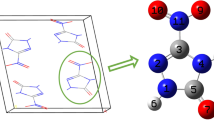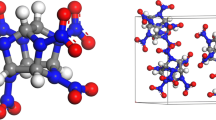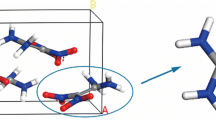Abstract
In this paper, a primary model is established for MD (molecular dynamics) simulation for the PBXs (polymer-bonded explosives) with RDX (cyclotrimethylene trinitramine) as base explosive and PS as polymer binder. A series of results from the MD simulation are compared between two PBX models, which are represented by PBX1 and PBX2, respectively, including one PS molecular chain having 46 repeating units and two PS molecular chains with each having 23 repeating units. It has been found that their structural, interaction energy and mechanical properties are basically consistent between the two models. A systematic MD study for the PBX2 is performed under NPT conditions at five different temperatures, i.e., 195 K, 245 K, 295 K, 345 K, and 395 K. We have found that with the temperature increase, the maximum bond length (L max) of RDX N−N trigger bond increases, and the interaction energy (E N-N) between two N atoms of the N−N trigger bond and the cohesive energy density (CED) decrease. These phenomena agree with the experimental fact that the PBX becomes more sensitive as the temperature increases. Therefore, we propose to use the maximum bond length L max of the trigger bond of the easily decomposed and exploded component and the interaction energy E N-N of the two relevant atoms as theoretical criteria to judge or predict the relative degree of heat and impact sensitivity for the energetic composites such as PBXs and solid propellants.
Similar content being viewed by others
References
Choi CS, Prince E. The crystal structure of cyclotrimethylenetrinitramine. Acta Cryst, 1972, B28: 2857–2862
Kishore K. Thermal decomposition studies on hexahydro-1,3,5-trinitro-s-triazine (RDX) by differential scanning calorimetry. Propell Explos Pyrotech, 1977, 2: 78–81
Schwarz RB, Hooks DE, Dick JJ, Archuleta JI, Martinez AR. Resonant ultrasound spectroscopy measurement of the elastic constants of cyclotrimethylene trinitramine. J Appl Phys, 2005, 98: 056106–056108
Haycraft JJ, Stevens LL, Eckhardt CJ. The elastic constants and related properties of the energetic material cyclotrimethylene trinitramine (RDX) determined by Brillouin scattering. J Chem Phys, 2006, 124: 024712-1–024712-11
Sorescu DC, Rice BM, Thompson DL. Intermolecular potential for the Hexahydro-1,3,5-trinitro-1,3,5-s-triazine crystal (RDX): A crystal packing, Monte Carlo, and molecular dynamics study. J Phys Chem, 1997, B101: 798–808
Xiao JJ, Ji GF, Yang D, Xiao HM. The DFT studies on structure and property of hexahydro-1,3,5-trinitro-2,4,6-triazine. Chin J Struct Chem, 2002, 21: 437–441
Swell TD, Bennett CM. Monte Carlo calculations of the elastic moduli and pressure-volume-temperature equation of state for hexahydro-1,3,5-trinitro-1,3,5-triazine. J Appl Phys, 2000, 88: 88–95
Strachan A, Kober E, van Duin ACT, Oxgaard J, Goddard III WA. Thermal decomposition of RDX from reactive molecular dynamics. J Chem Phys, 2005, 122: 054502-1–054502-10
Boyd S, Gravelle M, Politzer P. Nonreactive molecular dynamics force field for crystalline hexahydro-1,3,5-trinitro-1,3,5 triazine. J Chem Phys, 2006, 124: 104508-1–104508-10
Zheng L, Thompson DL. Molecular dynamics simulations of melting of perfect crystalline hexahydro-1,3,5-trinitro-1,3,5-s-triazine. J Chem Phys, 2006, 125: 084505-1–084505-9
Agrawal PM, Rice BM, Zheng L, Thompson DL. Molecular dynamics simulations of hexahydro-1,3,5-trinitro-1,3,5-s-triazine (RDX) using a combined Sorescu-Rice-Thompson AMBER force field. J Phys Chem, 2006, B110: 26185–26188
Zhu W, Xiao JJ, Zhu WH, and Xiao HM. Molecular dynamics simulations of RDX and RDX-based plastic-bonded explosives. J Hazards Mater, 2009, 164: 1082–1088
Zhou TT, Huang FL. Effects of defects on thermal decomposition of HMX via ReaxFF molecular dynamics simulations. J Phys Chem, 2011, B115: 278–287
Xiao HM, Xu XJ, Qiu L. Theoretical Design of High Energy Density Materials. Beijing: Science Press, 2008
Kamlet MJ, Adolph HG. The relationship of impact sensitivity with structure of organic high explosives. Propell Explos Pyrotech, 1979, 4: 30–34
Politzer P, Abrahmsen L, Sjoberg P. Effects of amino and nitro substituents upon the electrostatic potential of an aromatic ring. J Am Chem Soc, 1984, 106: 855–860
Xiao HM, Wang ZY, Yao JM. Quantum chemical study on sensitivity and stability of aromatic nitro explosives I. Nitro derivatives of aminobenzenes. Acta Chim Sinica, 1985, 43: 14–18
Politzer P, Murray JS. Relationships between dissociation energies and electrostatic potentials of C-NO2 bonds: Applications to impact sensitivities. J Mol Struct, 1996, 376: 419–424
Fan JF, Xiao HM. Theoretical study on pyrolysis and sensitivity of energetic compounds. (2) Nitro-derivatives of benzene. J Mol Struct (Theochem), 1996, 365: 225–229
Chen ZX, Xiao HM, Yang SL. Theoretical investigation on the impact sensitivity of tetrazolederivatives and their metal salts. Chem Phys, 1999, 250: 243–248
Rice BM, Hare JJ. A quantum mechanical investigation of the relation between impact sensitivity and the charge distribution in energetic molecules. J Phys Chem, 2002, A106: 1770–1783
Keshavarz MH. Prediction of impact sensitivity of nitroaliphatic, nitroaliphatic containing other functional groups and nitrate explosives. J Hazards Mater, 2007, 148: 648–652
Keshavarz MH, Jaafari M. Investigation of the various structure parameters for predicting impact sensitivity of energetic molecules via artificial neural network. Propell Explos Pyrotech, 2006, 31: 216–225
Benazet S, Jacob G, Pepe G. GenMol(TM) supramolecular descriptors predicting reliable sensitivity of energetic compounds. Propell Explos Pyrotech, 2009, 34: 120–135
Wang R, Jiang J, Pan Y, Cao H, Cui Y. Prediction of impact sensitivity of nitro energetic compounds by neural network based on electrotopological-state indices. J Hazards Mater, 2009, 166: 155–186
Xiao HM, Li YF, Qian JJ. A study on sensitivity and conductivity of alkali and heavy metal azides. Acta Phys Chim Sinica, 1994, 10: 235–240
Xiao HM, Li YF. Banding and electronic-structures of metal azides-sensitivity and conductivity. Science in China (Series B), 1995, 38: 538–545
Xiao HM, Li YF. Banding and Electronic Structures of Metal Azides-Sensitivity and Conductivity. Beijing: Science Press, 1996
Zhu WH, Xiao HM. First-principles band gap criterion for impact sensitivity of energetic crystals: A review. Struct Chem, 2010, 21: 657–665
Zhu W, Xiao JJ, Zheng J, Zhao XB, Chen ZE, Xiao HM. A theoretical criterion for sensitivity of energetic composites-molecular dynamics studies on AP/HMX systems at various concentrations and temperatures. Acta Chim Sinica, 2008, 66: 2592–2596
Zhu W, Wang XJ, Xiao JJ, Zhu WH, Sun H, Xiao HM. Molecular dynamics simulations of AP/HMX composite with a modified force field. J Hazards Mater, 2009, 167: 810–816
Xiao JJ, Ma XF, Zhu W, Xiao HM. Molecular dynamics simulations of polymer bonded-explosives (PBXs): Modeling, elastic properties and their dependence on temperatures and concentrations of binders. In: Proceedings of the eighth seminar “New trends in research of energetic materials”. Pardubice: The University of Pardubice, 2005. 19–21
Xu XJ, Xiao HM, Xiao JJ, Zhu W, Huang H, Li JS. Molecular dynamics simulations for pure ɛ-CL-20 and ɛ -CL-20-based PBXs. J Phys Chem. 2006, B110: 7203–7207
Qiu L, Xiao HM, Zhu WH, Xiao JJ, Zhu W. Ab initio and molecular dynamics studies of crystalline TNAD (trans-1,4,5,8-tetranitro-1,4,5,8-tetraazadecalin). J Phys Chem, 2006, B110: 10651–10661
Sun H. COMPASS: An ab initio force-field optimized for condensed-phase applications — Overview with details on alkane and benzene compounds. J Phys Chem, 1998, B102: 7338–7364
Hwang MJ, Stockfisch TP, Hagler AT. Derivation of class II force fields: 2. Derivation and characterization of a class-II force field, CFF93, for the alkyl functional group and alkane molecules. J Am Chem Soc, 1994, 116: 2515–2525
Maple JR, Hwang MJ, Stockfisch TP, Dinur U, Waldman M, Ewig CS, Hagler AT. Derivation of class-II force fields. 1. Methodology and quantum force-field for the alkyl functional group and alkane molecules. J Comput Chem, 1994, 15: 162–182
Lifson S, Hagler AT, Dauber P. Consistent force field studies of intermolecular forces in hydrogen-bonded crystals. 1. Carboxylic acids, amides, and the C=O…H Hydrogen bonds. J Am Chem Soc, 1979, 101: 5111–5121
Andersen HC. Molecular dynamics simulations at constant pressure and/or temperature. J Chem Phys, 1980, 72: 2384–2393
Parrinello M, Rahman A. Polymorphic transitions in single crystals: A new molecular dynamics method. J Appl Phys, 1981, 52: 7182–7190
Allen MP, Tildesley DJ. Computer Simulation of Liquids. Oxford: Oxford University Press, 1987
Politzer P, Murray JS, Lane P, Sjoberg P, Adolph HG. Shock-sensitivity relationships for nitramines and nitroaliphatics. Chem Phys Lett, 1991, 181:78–82
Author information
Authors and Affiliations
Corresponding authors
Rights and permissions
About this article
Cite this article
Xiao, J., Zhao, L., Zhu, W. et al. Molecular dynamics study on the relationships of modeling, structural and energy properties with sensitivity for RDX-based PBXs. Sci. China Chem. 55, 2587–2594 (2012). https://doi.org/10.1007/s11426-012-4797-1
Received:
Accepted:
Published:
Issue Date:
DOI: https://doi.org/10.1007/s11426-012-4797-1




